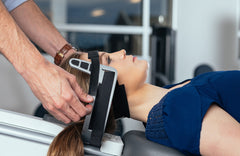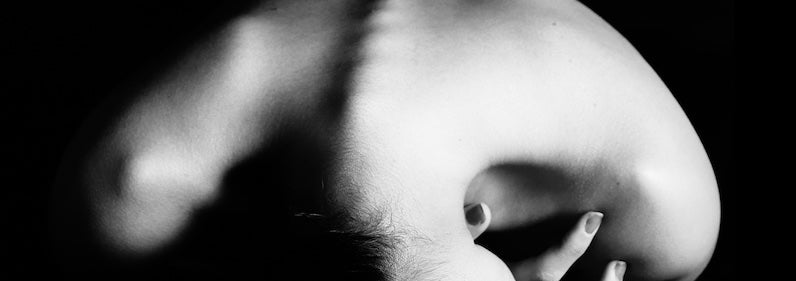Clinicians who treat the cervical spine use traction all the time. Some use their hands to deliver the traction force (manual traction). Others may use a device to help them out (mechanical traction).
I was trained as a manual therapist. When I work on the neck of a patient, I hold the head in both my hands and gradually add tension to the soft tissues. I add some rotation, some extension or flexion, some lateral flexion, until I find the right angle of pull where the muscles start relaxing. Blood flow will start to improve, pain will decrease and range of motion will improve. Traction does all that and more. It is a powerful form of joint and soft tissue mobilization, especially in the cervical spine.
Should I consider Mechanical Traction?
Manual therapists tend to consider using a mechanical traction device to assist in the delivery of traction with skepticism. They may think that it will take away from therapeutic effectiveness. We like manual contact because it gives us detailed information about the current state of the tissues – range of motion, pain, tone, etc. It allows us to quickly adjust tension and speed of motion based on what we feel with our hands. Would this be hindered in any way when using mechanical traction?
I no longer think so.
Manual versus Mechanical Traction
The question whether mechanical traction is better or worse than manual traction is the wrong question. It’s neither. Each treatment technique has its pros and cons. I can relieve pain with soft tissue mobilizations, with electrotherapy, with laser therapy, with shortwave diathermy, or with drugs using iontophoresis. Each has its own specific characteristics that make it more or less appropriate to the clinical scenario that I am facing. We must look at mechanical and manual traction in the same way: different ways of achieving the same thing.
Lets consider some limitations of the pure manual approach. One drawback is that in most cases we will need both of our hands to apply the traction force to the cervical spine. Other manual work, like working on a trigger point in the neck muscles for instance, is hard to do at the same time. In other words, we are constrained when performing manual traction; we can only do it and nothing else.
Another drawback: our hands will eventually get tired, especially when using greater amounts of force. I used to not believe this was a big issue until a patient once told me that his previous chiropractor used to pull the neck much harder and apparently with better results. I tried and he was right – we got better outcomes – but my hands had difficulty keeping up!
Mechanical traction is similar to manual traction in almost all key aspects of traction therapy. It also offers some significant benefits that create some unique opportunities for the manual therapist.
The main difference is that a mechanical device produces the pulling force to the cervical spine, not the clinician’s hands. This device will not fatigue and will not vary its pulling force. It can adjust its pulling force based on the patient’s muscle tension. It can also deliver a protocol of gradually increasing and then decreasing levels of tension over a set amount of time. In other words, it can replicate what I would normally be doing with my hands.
 It is important to point out that not all mechanical traction devices are created equal. Some devices like over-the-door devices or pneumatic home devices produce a static traction force only. To deliver traction therapy that effectively complements my manual therapy I am going to need a device that can produce intermittent traction at settings determined by me. These devices are typically also the ones that will qualify for reimbursement, but more about that in another post.
It is important to point out that not all mechanical traction devices are created equal. Some devices like over-the-door devices or pneumatic home devices produce a static traction force only. To deliver traction therapy that effectively complements my manual therapy I am going to need a device that can produce intermittent traction at settings determined by me. These devices are typically also the ones that will qualify for reimbursement, but more about that in another post.
Multimodal Treatment Protocol including Mechanical Traction
Today, a typical treatment session for my patient with cervical radiculopathy may look like this:
- 15 mins of mechanical traction using an evidence based progressive-regressive tension protocol
- 2 mins of high power laser therapy to key pain points (trigger and tender points)
- Mobilization and/or manipulation to the joints and soft tissues
- Possibly another 1 min of high power laser to mitigate the pain response to treatment
- Home exercise instruction
My advice to fellow manual therapists who regularly work on the cervical spine: try out adding mechanical traction to your treatment protocol to see what treatment opportunities it opens up for you. I bet you won’t be disappointed!

Yorick Wijting, PT, DPT (www.specialistpt.com) received his degree in Physical Therapy in the Netherlands and later his DPT at the University of St. Augustine in Florida. He has practiced physical therapy in various care settings across Europe, South Africa and the United States. He has extensive training and practical experience in electrotherapy and teaches nationally and internationally to medical professionals on its therapeutic use. He is passionate about helping clinicians discover how technology can enhance their efficiency and treatment outcomes.

